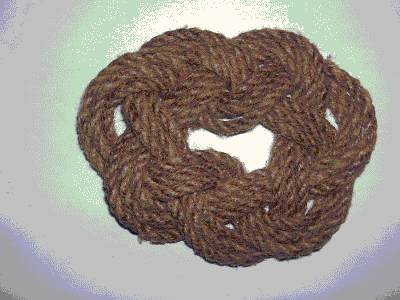![[my logo]](tctk-gr.gif)
My Logo
| Blackhead might be a lone wolf, a one-man band, but he was a force that had to be reckoned with, from whom there was no court of appeal, until once in a way Operations would cut the Gordian knot, brutally disregarding Blackhead himself, overriding his objections ... |
|
Anthony Powell |
A story is told that Gordius, in Greek mythology, king of Phrygia, had the pole of his wagon fastened to the yoke with a knot that defied efforts to untie it. An oracle stated that he who untied this Gordian knot would rule Asia. According to legend, Alexander The Great simply cut the knot with his sword. Which was a non-trivial and quite an unexpected solution. Sure enough, he has conquered a good deal of Asia eventually reaching as far East as Northern India.
![]()
Being an Alexander and living at 1 Alexander Road, one can imagine how often I have been asked if it is a coincidence. The association has not been lost on me. Not having global ambitions of Alexander The Great, I often reflected of how the Gordian knot might have looked like.
The design I came up with could not have been used by the king Gordius to fasten a yoke. However, it would certainly take Alexander's ingenuity to untie it.
Fold a narrow band of paper into a regular knot without crumpling it unnecessarily. Straighten all the wrinkles if you accidentally did. The knot should actually form a regular pentagon. It then follows that if the piece of paper is sufficiently long and one ties knots at equal distances from each other then after the fifth knot the two ends of paper will overlap. Now gluing them together will create a shape that I use as my logo.
It is actually easy to provide a rigorous proof that the design is feasible. What it takes is to demonstrate that the knot indeed shapes itself into the regular pentagon.
One additional remark: the logo proves to be a one-sided surface, akin to the Möbius band.
![]()

A follow up
Around the first anniversary of this page I ran into the gallery of symbolic sculptures by John Robinsohn. What do you know? One of his creations is the Gordian Knot. At first glance our visions of the famous knot are different. Or are they? By loosening my knot a little and replacing a strip of paper with a golden tube - I do think one can find a certain semblance between the two.
Two years later, I came across a small collection of Sam Loyd's puzzles. #117 expounds Loyd's version of the story. The great puzzlist severely berates the great conqueror for apparently eschewing to solve the puzzle.
Tom Longtin has a professional 3d rendition of my logo. (My sincere thanks to C. Schmach for providing the link.)
James Bissell-Thomas of the famous English globe maker Greaves & Thomas offers a deeper view on Alexander's encounter with the Gordian knot.
When Alexander cut the knot, to rule the world by force,
What then happened to the fine string,
Which had help bind the oxen, to keep it on its course?
Some said the thread was golden, fools melted some to see,
But the closest thing they missed, was the passing thought of Alchemy.(James also did an extensive study of Hans Holbein's famous "The Ambassadors" (1533) in which he discovered hidden signs pointing to a magic 6x6 square.)
Susan Keltner, a high school teacher from Arizona, wrote about her habit to tie drinking straws into knots. The ends of the straws then could be tucked successively to produce a closed shape with a nice 3D feeling.
Perhaps surprisingly, paper folding provides a geometric construction tool whose power far exceeds the conventional compass and ruler.
As the years went by, I discovered a rope creation by a Swedish author who placed his creation into Public Domain at Wikimedia Commons.

![]()
- An Interesting Example of Angle Trisection by Paperfolding
- Angle Trisection by Paper Folding
- Angles in Triangle Add to 180o
- Broken Chord Theorem by Paper Folding
- Dividing a Segment into Equal Parts by Paper Folding
- Egyptian Triangle By Paper Folding
- Egyptian Triangle By Paper Folding II
- Egyptian Triangle By Paper Folding III
- My Logo
- Paper Folding And Cutting Sangaku
- Parabola by Paper Folding
- Radius of a Circle by Paper Folding
- Regular Pentagon Inscribed in Circle by Paper Folding
- Trigonometry by Paper Folding
- Folding Square in a Line through the Center
- Tangent of 22.5o - Proof Without Words
- Regular Octagon by Paper Folding
- The Shortest Crease
- Fold Square into Equilateral Triangle
- Circle Center by Paperfolding
- Folding and Cutting a Square
![]()
|Contact| |Front page| |Contents| |Geometry|
Copyright © 1996-2018 Alexander Bogomolny
73598711
